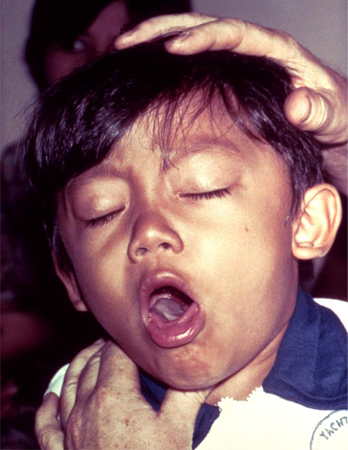Resumo
Definição
História e exame físico
Principais fatores diagnósticos
- faixa etária típica (<15 anos ou >25 anos de idade)
- exposição a um indivíduo infectado
- viagem proveniente de regiões endêmicas ou epidêmicas
- indivíduos não vacinados/com vacinação incompleta
- faringite
- disfagia ou disfonia
- dispneia
- tosse rouca
- formação de pseudomembrana
- edema cervical
- lesões cutâneas
- comprometimento respiratório
Outros fatores diagnósticos
- febre
- estridor
Fatores de risco
- indivíduos não vacinados
- indivíduos vacinados inadequadamente
- exposição a um indivíduo infectado
- viagens provenientes de regiões endêmicas
- ruptura da pele
- higiene deficiente, superpopulação e pobreza
Investigações diagnósticas
Primeiras investigações a serem solicitadas
- cultura bacteriana, microscopia e sensibilidades
Investigações a serem consideradas
- teste de Elek para toxigenicidade
- reação em cadeia da polimerase
- anticorpos contra difteria
Algoritmo de tratamento
contactantes próximos de casos respiratórios e cutâneos assintomáticos
difteria respiratória
difteria cutânea
portadores assintomáticos
Colaboradores
Autores
Derek Sloan, FRCP, PhD
Reader & Consultant Physician in Infectious Diseases
University of St Andrews & NHS Fife
Scotland
Infectious Diseases Referent
UK-Med
UK
Declarações
DS declares that he has no competing interests.
Agradecimentos
Dr Derek Sloan would like to gratefully acknowledge Dr Walid Abuhammour, Dr Sarmad Farook Yahya Alhamdani, and Dr Nida Yousef, previous contributors to this topic.
Declarações
WA, SFYA, and NY declare that they have no competing interests.
Revisores
William A. Petri, Jr, MD, PhD, FACP
Chief and Professor of Medicine
Division of Infectious Diseases and International Health
University of Virginia Health System
Charlottesville
VA
Declarações
WAP declares that he has no competing interests.
George Y. Wu, MD, PhD
Professor of Medicine
University of Connecticut Health Center
Farmington
CT
Declarações
GYW is on the medical advisory boards of the following: Gilead Sciences, Bristol-Myers Squibb, AbbVie, and Intercept.
Linda S. Nield, MD
Associate Professor of Pediatrics
West Virginia University School Of Medicine
Morgantown
WV
Declarações
LSN declares that she has no competing interests.
Referências
Principais artigos
Centers for Disease Control and Prevention. Manual for the surveillance of vaccine-preventable diseases. Chapter 1: diphtheria. Dec 2022 [internet publication].Texto completo
Centers for Disease Control and Prevention. CDC Yellow Book 2024: health information for international travel. Section 5: travel-associated infections & diseases: diphtheria. May 2023 [internet publication].Texto completo
UK Health Security Agency. Public health control and management of diphtheria in England: 2023 guidelines. Nov 2023 [internet publication].Texto completo
Artigos de referência
Uma lista completa das fontes referenciadas neste tópico está disponível para os usuários com acesso total ao BMJ Best Practice.

Diagnósticos diferenciais
- Faringite por Streptococcus pyogenes
- Epiglotite aguda
- Mononucleose infecciosa
Mais Diagnósticos diferenciaisDiretrizes
- Child and adolescent immunization schedule: recommendations for ages 18 years or younger, United States, 2025
- Infection control in healthcare personnel: epidemiology and control of selected infections transmitted among healthcare personnel and patients
Mais DiretrizesFolhetos informativos para os pacientes
Vacina DTP (difteria, tétano, poliomielite)
Vacina DTPa (difteria, tétano, poliomielite e coqueluche)
Mais Folhetos informativos para os pacientesConectar-se ou assinar para acessar todo o BMJ Best Practice
O uso deste conteúdo está sujeito ao nosso aviso legal